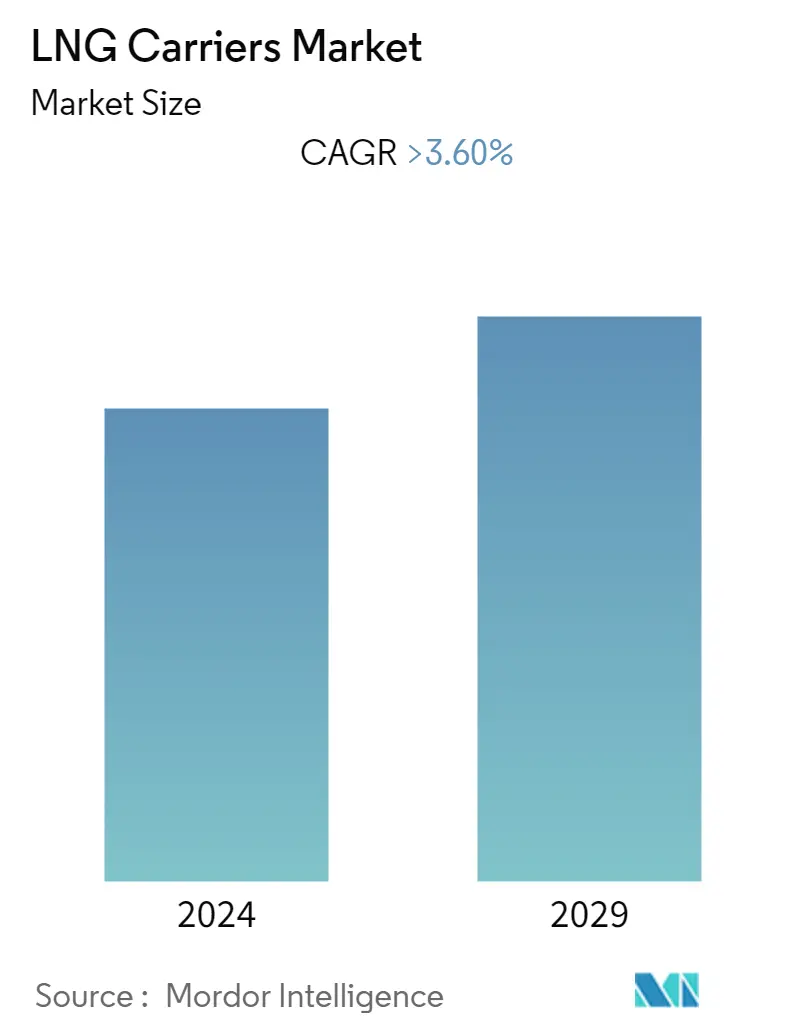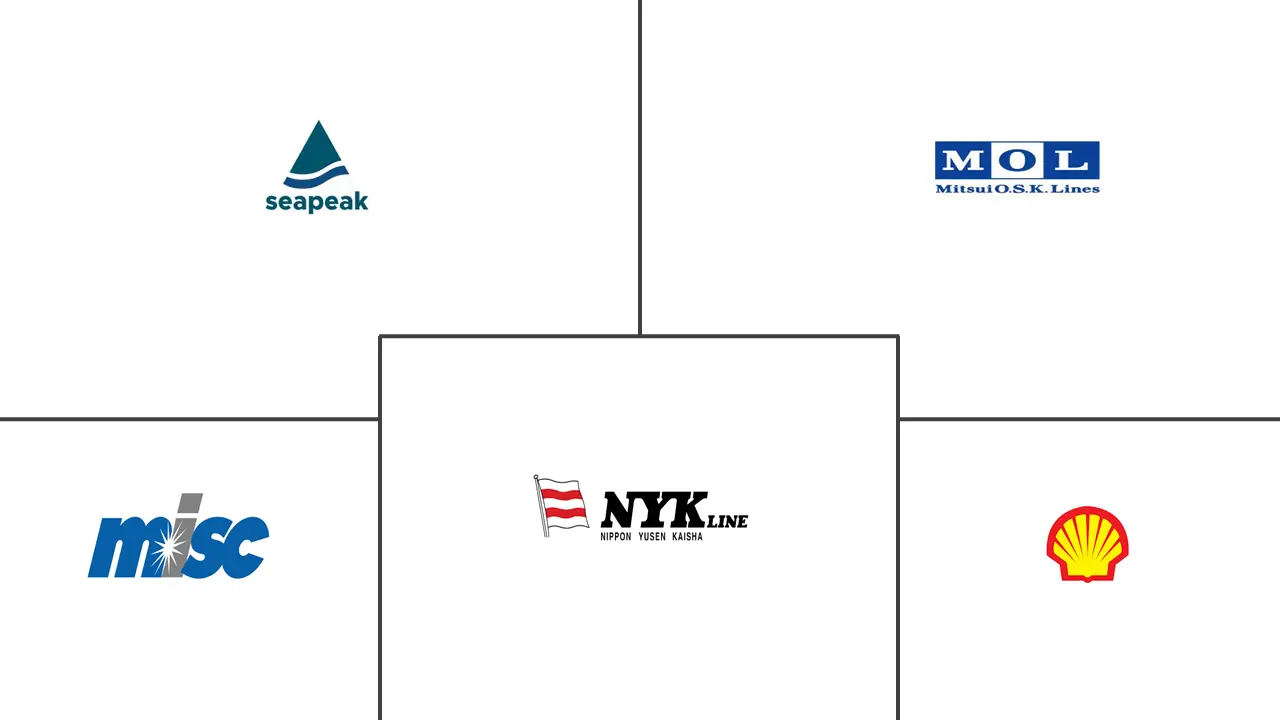Market Size of LNG Carriers Industry

| Study Period | 2019 - 2029 |
| Base Year For Estimation | 2023 |
| CAGR | 3.60 % |
| Fastest Growing Market | Europe |
| Largest Market | Asia Pacific |
| Market Concentration | Low |
Major Players
*Disclaimer: Major Players sorted in no particular order |
LNG Carrier Market Analysis
The LNG carrier market is expected to record a CAGR of more than 3.6% during the forecast period.
COVID-19 moderately impacted the market in 2020. Currently. The market has reached pre-pandemic levels.
- Over the medium period, factors such as flexible deployment capabilities, increased efficiency, and increasing global consumption of LNG driven by supportive government regulations and demand from several end-user industries, including power generation and industrial, are expected to drive the market in the coming years.
- On the other hand, with the new carrier fleet entering the market and with regional shipping imbalances, carriers' charter rates have fluctuated, which may hinder the market's growth during the forecast period.
- Nevertheless, many terminals are adjusting to accommodate small-scale and bunkering vessels to comply with emissions targets and capture new commercial opportunities. Conventional oil-based fuels will remain the main fuel option for most vessels in the future. At the same time, commercial opportunities of LNG are interesting.
LNG Carrier Industry Segmentation
An LNG carrier is a ship designed to transport liquefied natural gas in its chilled tanks. LNG carriers emit fewer greenhouse gases than conventional vessels because they are powered by natural gas.
The LNG Carrier market is segmented by containment type, propulsion type, and geography. By containment type, the market is segmented into membrane type and moss type. By propulsion type, the market is segmented into steam turbines, dual-fuel diesel engine/tri-fuel diesel engines (DFDE/TFDE), slow-speed diesel (SSD), M-type electronically controlled gas injection (ME-GI), XDF two-stroke engine, and steam re-heat and stage. The report also covers the market size and forecasts for the LNG carrier market across the major regions (North America, Europe, Asia-Pacific, Middle-East and Africa, and South America). For each segment, the market sizing and forecasts have been done on the revenue (USD billion).
| Containment Type | |
| Moss | |
| Membrane |
| Propulsion Type | |
| Steam Turbines | |
| Dual Fuel Diesel Engine/Tri-Fuel Diesel Engine (DFDE/TFDE) | |
| Slow-Speed Diesel (SSD) | |
| M-type Electronically Controlled Gas Injection (ME-GI) | |
| XDF Two-stroke Engine | |
| Steam Re-heat and Stage |
| Geography [Market Size and Demand Forecast till 2028 (for regions only)] | |||||||
| |||||||
| |||||||
| |||||||
| |||||||
|
LNG Carriers Market Size Summary
The LNG carrier market is poised for steady growth, driven by factors such as flexible deployment capabilities and increased efficiency. The market has rebounded to pre-pandemic levels, with supportive government regulations and rising global LNG consumption from sectors like power generation and industry fueling its expansion. However, fluctuations in charter rates due to new carrier fleets and regional shipping imbalances pose challenges to growth. Despite these hurdles, terminals are adapting to accommodate small-scale and bunkering vessels, aligning with emissions targets and exploring new commercial opportunities. While conventional oil-based fuels remain predominant, the commercial potential of LNG continues to attract interest.
The membrane-type containment segment dominates the LNG carrier market, favored for its higher carrying capacity and technological advancements that allow it to withstand LNG pressure. This segment is expected to maintain its leading position throughout the forecast period, with significant contracts awarded for new vessel designs. The Asia-Pacific region holds the largest market share, driven by high industrial growth and a shift towards clean energy, particularly in China, which has significantly increased its LNG consumption. The region's dominance is supported by rising LNG demand in countries like South Korea and Japan. The market is moderately fragmented, with key players including Royal Dutch Shell, Nippon Yusen Kabushiki Kaisha, and Mitsui O.S.K. Lines Ltd, among others, actively engaging in strategic partnerships and innovations to enhance their market presence.
LNG Carriers Market Size - Table of Contents
-
1. MARKET OVERVIEW
-
1.1 Introduction
-
1.2 Market Size and Demand Forecast in USD billion, till 2028
-
1.3 Global LNG Carrier Fleet (Historical and Forecast) in Number of Vessels, Until 2028
-
1.4 Recent Trends and Developments
-
1.5 Government Policies and Regulations
-
1.6 Market Dynamics
-
1.6.1 Drivers
-
1.6.2 Restraints
-
-
1.7 Supply Chain Analysis
-
1.8 Porter's Five Forces Analysis
-
1.8.1 Bargaining Power of Suppliers
-
1.8.2 Bargaining Power of Consumers
-
1.8.3 Threat of New Entrants
-
1.8.4 Threat of Substitutes Products and Services
-
1.8.5 Intensity of Competitive Rivalry
-
-
-
2. MARKET SEGMENTATION
-
2.1 Containment Type
-
2.1.1 Moss
-
2.1.2 Membrane
-
-
2.2 Propulsion Type
-
2.2.1 Steam Turbines
-
2.2.2 Dual Fuel Diesel Engine/Tri-Fuel Diesel Engine (DFDE/TFDE)
-
2.2.3 Slow-Speed Diesel (SSD)
-
2.2.4 M-type Electronically Controlled Gas Injection (ME-GI)
-
2.2.5 XDF Two-stroke Engine
-
2.2.6 Steam Re-heat and Stage
-
-
2.3 Geography [Market Size and Demand Forecast till 2028 (for regions only)]
-
2.3.1 North America
-
2.3.1.1 United States
-
2.3.1.2 Canada
-
2.3.1.3 Rest of the North America
-
-
2.3.2 Asia-Pacific
-
2.3.2.1 China
-
2.3.2.2 India
-
2.3.2.3 Japan
-
2.3.2.4 South Korea
-
2.3.2.5 Rest of the Asia-Pacific
-
-
2.3.3 Europe
-
2.3.3.1 Germany
-
2.3.3.2 France
-
2.3.3.3 Spain
-
2.3.3.4 United Kingdom
-
2.3.3.5 Rest of the Europe
-
-
2.3.4 South America
-
2.3.4.1 Brazil
-
2.3.4.2 Argentina
-
2.3.4.3 Rest of the South America
-
-
2.3.5 Middle-East and Africa
-
2.3.5.1 United Arab Emirates
-
2.3.5.2 Nigeria
-
2.3.5.3 Saudi Arabia
-
2.3.5.4 Rest of the Middle-East and Africa
-
-
-
LNG Carriers Market Size FAQs
What is the current LNG Carriers Market size?
The LNG Carriers Market is projected to register a CAGR of greater than 3.60% during the forecast period (2024-2029)
Who are the key players in LNG Carriers Market?
Royal Dutch Shell PLC, Nippon Yusen Kabushiki Kaisha, MISC Berhad, Mitsui O.S.K. Lines Ltd and Seapeak are the major companies operating in the LNG Carriers Market.

